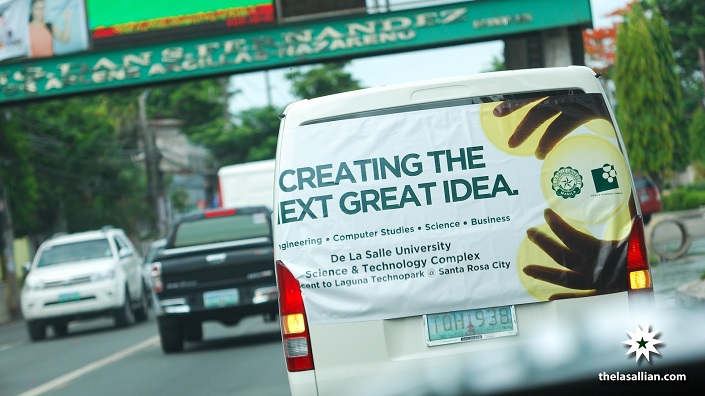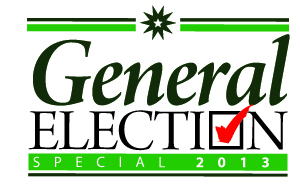
It was a quiet, idyllic, ordinary March morning, when the students of De La Salle University Science and Technology Complex (DLSU-STC) suddenly started seeing red.
Yellow, too – then black, orange, white and blue, marking the start of the premiere campaign period and subsequent student elections in the DLSU-STC campus.
A perplexed DLSU-STC student chanced upon the gathering political parties and asked, “Why are they all wearing blue and red?”
This is March 7, the first University Student Government (USG) Executive Board (EB) campaign since the DLSU-STC merger. During this time period, candidates exchanged handshakes as they announced their platforms through their usual energetic room-to-room intermissions. Likewise, the Science and Technology Complex Government (STCG) candidates campaigned in a similar fashion for the succeeding days.
Under the DLSU-STC merger, the University Student Government’s (USG) Executive Board (EB), along with the rest of DLSU-M’s student services offices, will assume their respective roles of responsibility over the Canlubang campus. Come election time, the two student bodies will become one under the integration. This year’s EB candidates will be wielding their mandate over DLSU-STC’s entire student body.
DLSU’s Commission on Elections (COMELEC) Head Alvin Liu elaborates that the election process of DLSU-STC will be mirrored with that of DLSU. It will follow the same processes implemented in the Manila campus, with the only major difference being that their elections are automated, and ours are done by scannable ballots.
Liu adds that the Student Government in DLSU-STC usually organizes a political party only once election period is nearing, as opposed to having constant, consistent, established political parties with nearly half a decade of history. This is majorly due to the small student population of DLSU-STC.
In several instances prior to the campaign period, the USG EB and both political parties reported to DLSU-STC. This was an effort to introduce the STC students to the USG, as well as brief them on both parties’ political platforms.
A shaky impression
“The students adopted Santugon and Tapat in a different way,” says Tapat’s Campus President candidate Aubrey Tolentino. Their campus’ campaign week was now a shower of bright colors, enunciated shouts and catchy phrases. She recounts how some students, carried by the tide, joined parties despite not knowing what was happening, and they picked their parties based on who campaigned to them first.
Karen, a non-partisan junior BSE student belonging to STC’s Office of Student Affairs, now describes the introduction of the EB candidates as ‘intense’ and competitive. Juxtaposed with DLSU-STC’s previous approach, the EB candidates’ introduction ignited the small community – who was prior used to a network within the campus wherein “everyone knew each other”; they knew and were on overall good terms with who they were voting for.
Although Karen is excited for the DLSU merger, she admits that it may be too soon for the EB to assume authority over DLSU-STC, despite having representation. “Baka magkagulo lang [It might become messy],” she fears.
Incumbent STC College Council Vice President and Santugon candidate for the STCG President Nins Talens explains that the STCG is a pilot government created in line with the newly implemented integration project.
While Talens confirms that not much is being shared with the students with regards to updates on the merger project, it is only because the administration is still deliberating on final plans.
Tolentino admits that despite efforts from both political parties, students have a hard time growing accustomed to the new political candidates due to logistical complications. In Filipino, she explains that what originally started out as a venture to inform STC students on their new government took a downwards slope. She elaborates that out of 30 classes meant to be visited, their EB hopefuls had only visited seven classes due to DLSU-STC’s scheduled College Week happening at the same time. The EB hadn’t returned the next day, due to impracticality.
It was no better even before, though: Tolentino says that DLSU-STC students were supposedly complacent come election time, due to the former student government’s difficulties in campaigning, disseminating information and capturing the interest of the students.
But is this truly better? The situation has regressed into a too-familiar model of personality politics, where students are swayed by the bandwagon by virtue of not having any other choice, or campaigns that breeze by with no prior context.
Does the concern stop at mere logistics and physical facilities? Quantitative constraints are more easily corrected – transportation, gas fees, toll fees, campus resources, and the time cost – the issue about DLSU-STC’s one-hour geographical distance and facilities become seemingly minute on the get-go.
Yet, the STCG candidates repeatedly cite logistics and the Handbook discrepancies in the dress code policies as some main issues their constituents now face. Perhaps what should be further scrutinized by their stakeholders – namely, the students – is the rapid submission of the STCG under the USG.
Firstly, while the current Executive Board and vying candidates from either political party eye DLSU-STC as an area of concern, they have yet to manifest a specific plan of action that goes beyond ‘we’ll see from here.’
It is concerning that these same representatives were swept along with the integration project, despite students in both campuses not being openly briefed on the developments occurring behind the merger nor openly consulted prior to the DLSU-STC merger, causing a great deal of confusion.
Likewise, while DLSU’s own student body cites continuing issues and pleas for attention towards problems regarding student’s rights and welfare in their own University, what more would DLSU-STC’s studentry know?
 Beyond a brighter campaign style embellished with power stances and gleaming smiles, educated voting comes from a prolonged familiarity with the problems of one’s community and, perhaps more importantly, knowledge of the leader to vote for in the first place.
Beyond a brighter campaign style embellished with power stances and gleaming smiles, educated voting comes from a prolonged familiarity with the problems of one’s community and, perhaps more importantly, knowledge of the leader to vote for in the first place.
